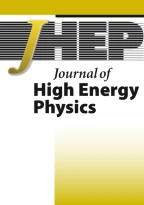Abstract
We calculate anomaly induced conductivities from a holographic gauge theory model using Kubo formulas, making a clear conceptual distinction between thermodynamic state variables such as chemical potentials and external background fields. This allows us to pinpoint ambiguities in previous holographic calculations of the chiral magnetic conductivity. We also calculate the corresponding anomalous current three-point functions in special kinematic regimes. We compare the holographic results to weak coupling calculations using both dimensional regularization and cutoff regularization. In order to reproduce the weak coupling results it is necessary to allow for singular holographic gauge field configurations when a chiral chemical potential is introduced for a chiral charge defined through a gauge invariant but non-conserved chiral density. We argue that this is appropriate for actually addressing charge separation due to the chiral magnetic effect.
Similar content being viewed by others
References
D.T. Son and A.R. Zhitnitsky, Quantum anomalies in dense matter, Phys. Rev. D 70 (2004) 074018 [hep-ph/0405216] [SPIRES].
M.A. Metlitski and A.R. Zhitnitsky, Anomalous axion interactions and topological currents in dense matter, Phys. Rev. D 72 (2005) 045011 [hep-ph/0505072] [SPIRES].
G.M. Newman and D.T. Son, Response of strongly-interacting matter to magnetic field: Some exact results, Phys. Rev. D 73 (2006) 045006 [hep-ph/0510049] [SPIRES].
J. Charbonneau and A. Zhitnitsky, Topological Currents in Neutron Stars: Kicks, Precession, Toroidal Fields and Magnetic Helicity, JCAP 08 (2010) 010 [arXiv:0903.4450] [SPIRES].
D. Kharzeev, Parity violation in hot QCD: Why it can happen and how to look for it, Phys. Lett. B 633 (2006) 260 [hep-ph/0406125] [SPIRES].
D. Kharzeev and A. Zhitnitsky, Charge separation induced by P-odd bubbles in QCD matter, Nucl. Phys. A 797 (2007) 67 [arXiv:0706.1026] [SPIRES].
D.E. Kharzeev, L.D. McLerran and H.J. Warringa, The effects of topological charge change in heavy ion collisions: ‘Event by event P and CP-violation’, Nucl. Phys. A 803 (2008) 227 [arXiv:0711.0950] [SPIRES].
K. Fukushima, D.E. Kharzeev and H.J. Warringa, The Chiral Magnetic Effect, Phys. Rev. D 78 (2008) 074033 [arXiv:0808.3382] [SPIRES].
D.E. Kharzeev and H.J. Warringa, Chiral Magnetic conductivity, Phys. Rev. D 80 (2009) 034028 [arXiv:0907.5007] [SPIRES].
A.Y. Alekseev, V.V. Cheianov and J. Fröhlich, Universality of transport properties in equilibrium, Goldstone theorem and chiral anomaly, cond-mat/9803346 [SPIRES].
STAR collaboration, B.I. Abelev et al., Azimuthal Charged-Particle Correlations and Possible Local Strong Parity Violation, Phys. Rev. Lett. 103 (2009) 251601 [arXiv:0909.1739] [SPIRES].
STAR collaboration, S.A. Voloshin, Probe for the strong parity violation effects at RHIC with three particle correlations, arXiv:0806.0029 [SPIRES].
F. Wang, Effects of Cluster Particle Correlations on Local Parity Violation Observables, Phys. Rev. C 81 (2010) 064902 [arXiv:0911.1482] [SPIRES].
M. Asakawa, A. Majumder and B. Müller, Electric Charge Separation in Strong Transient Magnetic Fields, Phys. Rev. C 81 (2010) 064912 [arXiv:1003.2436] [SPIRES].
P.V. Buividovich, M.N. Chernodub, E.V. Luschevskaya and M.I. Polikarpov, Numerical evidence of chiral magnetic effect in lattice gauge theory, Phys. Rev. D 80 (2009) 054503 [arXiv:0907.0494] [SPIRES].
P.V. Buividovich et al., Magnetic-Field-Induced insulator-conductor transition in SU(2) quenched lattice gauge theory, Phys. Rev. Lett. 105 (2010) 132001 [arXiv:1003.2180] [SPIRES].
G. Lifschytz and M. Lippert, Anomalous conductivity in holographic QCD, Phys. Rev. D 80 (2009) 066005 [arXiv:0904.4772] [SPIRES].
H.-U. Yee, Holographic Chiral Magnetic Conductivity, JHEP 11 (2009) 085 [arXiv:0908.4189] [SPIRES].
A. Rebhan, A. Schmitt and S.A. Stricker, Anomalies and the chiral magnetic effect in the Sakai-Sugimoto model, JHEP 01 (2010) 026 [arXiv:0909.4782] [SPIRES].
W.A. Bardeen, Anomalous Ward identities in spinor field theories, Phys. Rev. 184 (1969) 1848 [SPIRES].
C.T. Hill, Anomalies, Chern-Simons terms and chiral delocalization in extra dimensions, Phys. Rev. D 73 (2006) 085001 [hep-th/0601154] [SPIRES].
H.U. Yee, Holographic Chiral Magnetic Conductivity, Chiral Shear Wave, and Chiral Magnetic Spiral, Talk given at Workshop on P-and CP-odd Effects in Hot and Dense Matter, Brookhaven U.S.A., April 26–30 2010.
T. Sakai and S. Sugimoto, Low energy hadron physics in holographic QCD, Prog. Theor. Phys. 113 (2005) 843 [hep-th/0412141] [SPIRES].
T. Sakai and S. Sugimoto, More on a holographic dual of QCD, Prog. Theor. Phys. 114 (2005) 1083 [hep-th/0507073] [SPIRES].
A. Gorsky, P.N. Kopnin and A.V. Zayakin, On the Chiral Magnetic Effect in Soft-Wall AdS/QCD, Phys. Rev. D 83 (2011) 014023 [arXiv:1003.2293] [SPIRES].
V.A. Rubakov, On chiral magnetic effect and holography, arXiv:1005.1888 [SPIRES].
G.D. Moore and M. Tassler, The Sphaleron Rate in SU(N) Gauge Theory, arXiv:1011.1167 [SPIRES].
K. Ghoroku, M. Ishihara and A. Nakamura, D3/D7 holographic Gauge theory and Chemical potential, Phys. Rev. D 76 (2007) 124006 [arXiv:0708.3706] [SPIRES].
S.L. Adler, Axial vector vertex in spinor electrodynamics, Phys. Rev. 177 (1969) 2426 [SPIRES].
J.S. Bell and R. Jackiw, A PCAC puzzle: π 0 → γγ in the σ-model, Nuovo Cim. A 60 (1969) 47 [SPIRES].
D.T. Son and A.O. Starinets, Minkowski-space correlators in AdS/CFT correspondence: Recipe and applications, JHEP 09 (2002) 042 [hep-th/0205051] [SPIRES].
C.P. Herzog and D.T. Son, Schwinger-Keldysh propagators from AdS/CFT correspondence, JHEP 03 (2003) 046 [hep-th/0212072] [SPIRES].
M. Kaminski, K. Landsteiner, J. Mas, J.P. Shock and J. Tarrio, Holographic Operator Mixing and Quasinormal Modes on the Brane, JHEP 02 (2010) 021 [arXiv:0911.3610] [SPIRES].
N.P. Landsman and C.G. van Weert, Real and Imaginary Time Field Theory at Finite Temperature and Density, Phys. Rept. 145 (1987) 141 [SPIRES].
T.S. Evans, The Condensed Matter Limit of Relativistic QFT, hep-ph/9510298 [SPIRES].
Author information
Authors and Affiliations
Corresponding author
Additional information
ArXiv ePrint: 1005.2587
Rights and permissions
About this article
Cite this article
Gynther, A., Landsteiner, K., Pena-Benitez, F. et al. Holographic anomalous conductivities and the chiral magnetic effect. J. High Energ. Phys. 2011, 110 (2011). https://doi.org/10.1007/JHEP02(2011)110
Received:
Revised:
Accepted:
Published:
DOI: https://doi.org/10.1007/JHEP02(2011)110


